Reptiles and Amphibians
Media

Species Types
Scientific Name
Plethodon angusticlavius
Description
The Ozark zigzag salamander is small and slender, with a narrow, somewhat lobed back stripe that can be yellow, orange, or red. This woodland species lives in Missouri’s southwestern counties along the Arkansas border.
Media
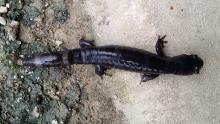
Species Types
Scientific Name
Ambystoma opacum
Description
The marbled salamander is a small, stout salamander with silvery, white, or gray saddle-shaped markings on its body from head to tail. They occur in the southeastern half of the state and are seldom encountered except during the autumn breeding season.
Media

Species Types
Scientific Name
Sonora semiannulata semiannulata
Description
The variable groundsnake is a small species with smooth, shiny scales and highly variable coloration. In Missouri, it is mostly restricted to open, rocky hillsides of the southwestern corner of the state.
Media
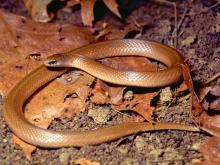
Species Types
Scientific Name
Virginia valeriae elegans
Description
The western smooth earthsnake is a small, plain, slightly stout snake. It is generally gray, brown, or reddish brown, with few distinct markings. It occurs statewide, except for the northwestern corner.
Media

Species Types
Scientific Name
Plethodon serratus
Description
The southern red-backed salamander is small and slender, with a distinct, narrow, red or orange stripe along the back that has saw-toothed edges. It hides under rocks, mosses, and rotten logs in Ozark forests.
Media
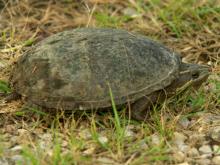
Species Types
Scientific Name
Sternotherus odoratus
Description
The eastern musk turtle is one of the world’s smallest turtles. It has a dark, domed upper shell and reduced lower shell. It occurs along our Mississippi River counties and in the southern two-thirds of the state.
Media

Species Types
Scientific Name
Apalone spinifera spinifera
Description
The eastern spiny softshell is a medium to large softshell turtle with small bumps or spines on the front edge of the upper shell. There are dark spots on the fore- and hind limbs.
Media
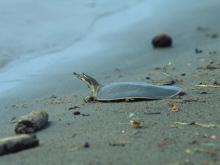
Species Types
Scientific Name
Apalone mutica mutica
Description
The midland smooth softshell is a rather plain-looking softshell turtle, with a smooth, rather featureless olive-gray or brown shell, and a light stripe bordered by black extending backward from each eye.
Media

Species Types
Scientific Name
Lithobates palustris (formerly Rana palustris)
Description
The pickerel frog is medium-sized, with square or rectangular spots in two parallel rows down the back. There is a distinct ridge of skin along each side of the back. It is absent from the northwestern third of Missouri.
Media
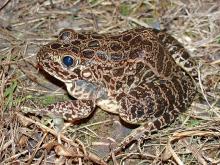
Species Types
Scientific Name
Lithobates areolatus circulosus
Description
A very secretive species, the northern crawfish frog spends most of its time hidden burrows, typically those made by crayfish. It is restricted to native prairie or former prairie areas and is a species of conservation concern in Missouri.
See Also
About Reptiles and Amphibians in Missouri
Missouri’s herptiles comprise 43 amphibians and 75 reptiles. Amphibians, including salamanders, toads, and frogs, are vertebrate animals that spend at least part of their life cycle in water. They usually have moist skin, lack scales or claws, and are ectothermal (cold-blooded), so they do not produce their own body heat the way birds and mammals do. Reptiles, including turtles, lizards, and snakes, are also vertebrates, and most are ectothermal, but unlike amphibians, reptiles have dry skin with scales, the ones with legs have claws, and they do not have to live part of their lives in water.





















